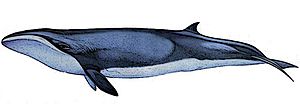Pygmy right whale facts for kids
The pygmy right whale (Caperea marginata) is a very special type of whale. It's the smallest of all the baleen whales, which are whales that have baleen plates instead of teeth to filter their food. For a long time, scientists thought its relatives were all extinct, but in 2012, they discovered it's actually a "living fossil"! This means it's the only living member of an ancient group of whales called cetotheres.
Pygmy right whales are usually about 6 to 6.5 meters (20 to 21 feet) long and weigh between 3,000 and 3,500 kilograms (6,600 to 7,700 pounds). Even though it's called a "right whale," it might be more closely related to gray whales and rorquals than to the larger bowhead and right whales.
You can find pygmy right whales in the cooler waters of the Southern Hemisphere. They mostly eat tiny creatures like copepods and krill. We don't know much about how many of them there are or how they live in groups, because they are rarely seen. Unlike many other baleen whales, people haven't hunted them much.
Quick facts for kids Pygmy right whale |
|
|---|---|
 |
|
 |
|
| Size compared to an average human | |
| Conservation status | |
| Scientific classification | |
| Genus: |
Caperea
|
| Species: |
marginata
|
 |
|
| Pygmy right whale range | |
Contents
Discovering the Pygmy Right Whale
Scientists first found bones and baleen plates of a pygmy right whale during a sea trip by James Clark Ross between 1839 and 1843. These parts looked like a smaller version of the larger right whale.
In 1846, a scientist named John Edward Gray officially described this new species. He named it Balaena marginata. Later, in 1864, Gray created a new group, or genus, for it called Caperea. The name Caperea means "wrinkle" in Latin, which refers to the wrinkled look of its ear bone. Marginata means "enclosed with a border," because of the dark border around its baleen plates.
In 2012, another scientist named Felix Marx studied the skull bones of pygmy right whales. He compared them to very old, extinct whales. He found that the pygmy right whale is closely related to the Cetotheriidae, an ancient group of whales. This discovery made the pygmy right whale a "living fossil" – a living animal that is the last of a very old group.
What Does the Pygmy Right Whale Look Like?
The pygmy right whale is very hard to find and study, so we don't know a lot about it. But we do know it's the smallest of all the baleen whales.
Size and Appearance
Baby pygmy right whales are thought to be about 1.6 to 2.2 meters (5 to 7 feet) long when they are born. They grow to about 3 to 3.5 meters (10 to 11.5 feet) long when they stop drinking their mother's milk. They become adults when they are about 5 meters (16 feet) long and fully grown at about 6 meters (20 feet). The longest male found was 6.1 meters (20 feet) long, and the longest female was 6.45 meters (21 feet) long. These whales can weigh up to 3,430 kilograms (7,560 pounds).
Pygmy right whales are dark gray on top and lighter gray underneath. They often have two light, V-shaped patches behind their eyes. From a distance, they can look a lot like dwarf minke or Antarctic minke whales.
Unique Features
One of the best ways to tell a pygmy right whale apart is by its long, narrow, cream-colored baleen plates. These plates have a clear white line along their gums. Unlike other "true" right whales, pygmy right whales do not have rough patches called callosities on their heads.
Their dorsal fin (the fin on their back) is shaped like a crescent moon. It's located about three-quarters of the way down their back. When they dive, they usually don't lift their tail flukes out of the water, which is similar to minke whales.
The skull and skeleton of the pygmy right whale are quite different from other living whales. For example, all seven of their neck bones are fused together. They also have 18 pairs of wide, flat ribs. Their lungs and heart are fairly small, which suggests they don't dive very deep.
What Do They Eat and How Do They Live?
Scientists have looked at the stomach contents of dead pygmy right whales. This showed that they eat tiny copepods and euphausiids (which are also known as krill).
We don't know much about how they live in groups or how they find mates. They are usually seen alone or in pairs. Sometimes, they are seen with other whales, like dolphins, pilot whales, minke whales, and even a sei whale mother and calf once.
Occasionally, larger groups have been seen. In 2001, a group of 14 was spotted southeast of New Zealand. In 1992, about 80 individuals were seen southwest of Cape Leeuwin in Australia. And in 2007, a group of over 100 pygmy right whales was seen near Portland, Victoria.
Where Do Pygmy Right Whales Live?
The pygmy right whale is one of the least studied whales. Before 2008, people had only seen them at sea fewer than 25 times!
These whales live in the Southern Hemisphere. They are believed to live all around the world in a band between about 30°S and 55°S latitude. This is where the surface water temperatures are between 5 and 20 degrees Celsius (41 and 68 degrees Fahrenheit). Pygmy right whales have been found off the coasts of Chile, Tierra del Fuego, Namibia, South Africa, Australia, and New Zealand. It's thought that one group might live off Tasmania all year long. We don't know how many pygmy right whales there are in total.
Pygmy Right Whales and People
Because pygmy right whales are relatively small and spread out, whalers have rarely hunted them. A few have been caught by accident in fishing nets. However, these activities are not thought to have greatly affected their overall population.
Most of what we know about pygmy right whales comes from individuals that have washed up on beaches. Since they are so rarely seen at sea, they are not usually the main focus of whale watching tours.
Protecting Pygmy Right Whales
The pygmy right whale is listed on Appendix II of the Convention on the Conservation of Migratory Species of Wild Animals (CMS). This means their conservation status is not ideal, and they would benefit a lot from international teamwork to protect them.
The pygmy right whale is also part of the Memorandum of Understanding for the Conservation of Cetaceans and Their Habitats in the Pacific Islands Region (Pacific Cetaceans MOU). This agreement helps protect whales and their homes in the Pacific Islands.
Images for kids
See also
 In Spanish: Ballena franca pigmea para niños
In Spanish: Ballena franca pigmea para niños



